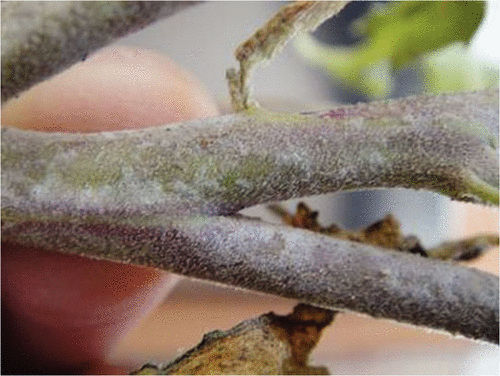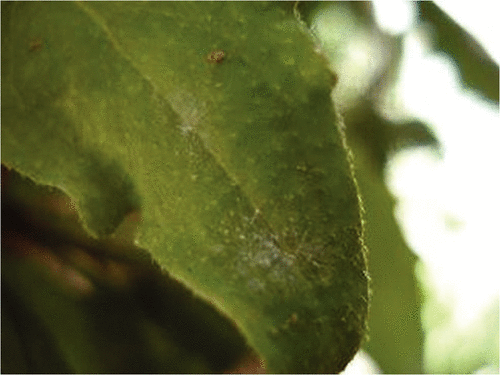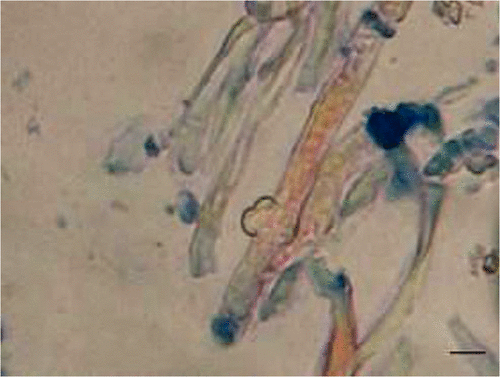Malcolmia africana, a new host for powdery mildew disease caused by Erysiphe cruciferarum in Iran
M. R. Mirzaee A D , A. Khodaparast B , S. Sajedi C , S. B. Javadi C and M. H. Saberi AA Agricultural and Natural Resources Research Center of Southern Khorasan, PO Box 413, Birjand, Iran.
B Department of Plant Protection, College of Agriculture, University of Guilan, PO Box 41889, Rasht 41635-1314, Iran.
C Iranian Research Institute of Plant Protection, PO Box 1454, Tehran 19395, Iran.
D Corresponding author. Email: reza.mirzaee.mrz@gmail.com
Australasian Plant Disease Notes 5(1) 101-102 https://doi.org/10.1071/DN10036
Submitted: 17 June 2010 Accepted: 8 September 2010 Published: 27 September 2010
Abstract
Powdery mildew disease of Malcolmia africana caused by Erysiphe cruciferarum is newly recorded from Iran. This is the first report of this fungal pathogen on Malcolmia africana worldwide.
Malcolmia africana, African mustard, is an annual, dicotyledonous herb, belonging to the Brassicaceae family. It is distributed in southern Europe, North Africa, central and south-west Asia and China and is documented as a weed of saffron fields in Khorasan province, Iran (Makarian et al. 2008).
In February 2010, powdery mildew symptoms were observed on the stems, and occasionally the rosetta leaves of approximately 10 plants of M. africana in the Siyujan region (32°53′N, 59°13′E), southern Khorasan, Iran. Dense white mycelial patches ranging from 5 mm to 25 mm in length were present on stems (Fig. 1). Hyphae were also present on the upper surface of the leaves, although severe symptoms on infected leaves were not noted (Fig. 2). A representative specimen has been deposited in The University of Guilan Mycological Herbarium, voucher number 670.

|

|
Fresh powdery mildew mycelia were detached from the symptomatic stems and leaves of five infected plants with a razor blade, mounted on a microscope slide and examined in water under a light microscope. At least 50 measurements for each character were taken per sample.
Conidia were hyaline, cylindrical, single (occasionally in short chains), germinated at the ends and measured 25–40 × 12.5–17.5 μm with a length-to-width (L/W) ratio greater than two (Fig. 3). Appressoria were moderately lobed and conidiophores were hyaline, unbranched, straight, composed of 3–4 cells, 75–112 × 9–12 µm (Figs 4 and 5). Foot cells were cylindrical, measuring an average of 20–26 × 8–10 μm. Fibrosin bodies were not present. The teleomorphic state of this fungus was not found, but the observed morphological characteristics were consistent with Erysiphe cruciferarum (Braun 1987, 1995; Kaur et al. 2008).

|

|

|
Although Erysiphe cruciferarum has been reported previously on numerous species in the Brassicaceae family, including Malcolmia maritima and M. incana from Canada, France, Germany and Italy (Farr et al. 2009), to our knowledge this is the first report of E. cruciferarum infecting a species in the genus Malcolmia in Iran and M. africana worldwide.
Braun U
(1987) A monograph of the Erysiphaceae (powdery mildews). Beihefte zur Nova Hedwigia 89, 1–700.
(verified 12 November 2009).
Kaur P,
Li CX,
Barbetti MJ,
You MP,
Li H, Sivasithamparam K
(2008) First report of powdery mildew caused by Erysiphe cruciferarum on Brassica juncea in Australia. Plant Disease 92, 650.
| Crossref | GoogleScholarGoogle Scholar |

Makarian M,
Rashed-Mohassel MH,
Bannayan M, Nassiri M
(2008) Spatial dynamics of weed populations in saffron (Crocus sativus) fields using geostatistics. Journal of Agricultural Sciences and Natural Resources 15, 76–85.



